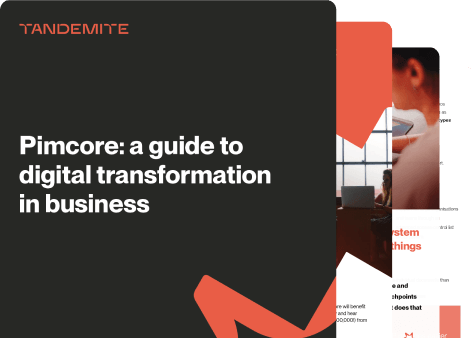With more than 2.14 billion online shoppers globally, 90,000 e-commerce businesses in Poland alone and the digitisation of businesses initiated by covid-19 accelerating in earnest, the competition for online sales is immense. To surpass it, you need to scale, automate processes, optimise costs and have a flexible approach to change. A solution that helps you achieve this with product information management is Pimcore. It is already used by over 100,000 organisations across 56 countries. Why should your company join them?
What does Pimcore bring to e-commerce?
From this article you will learn:
- How can PIM help e-commerce build a competitive advantage?
- What are the two ways to implement PIM?
- When can a PIM implementation be risky?
Pimcore is a platform equipped with MDM (Master Data Managment), DAM (Digital Asset Managment), CDP (Customer Data Platform) and PIM (Product Information Managment) modules.
In the context of e-commerce, the Pimcore platform can support project such as:
- The aforementioned PIM systems (including those created for integration with e-commerce platforms and marketplaces, such as eBay, Allegro or Amazon).
- E-commerce systems with a non-standard model (e.g. reservation, subscription, B2B or content-based sales of specific products).
- Pimcore can also serve as a DAM platform for media management.
Pimcore's integrated DAM tools allow for efficient management of media, such as image files, videos or documents. This makes it easier to control the quality of materials used for different types of advertising (both in print and OOH and DOOH or web services).
Pimcore enables advanced integrations according to the ‘connect anything’ principle, based on API (Application Programming Interface, which, simply speaking, is a means of communication between applications: it makes data from one application securely accessible in another). The platform can be connected to systems such as ERP (Enterprise Resource Planning), CRM (Customer Relationship Management), BI (Business Intelligence) or ESB (Enterprise Service Bus), thus adapting to your needs.
How does PIM support e-commerce to build competitive advantage?
The end of data silos
PIM helps to eliminate the problem of data silos, i.e. the storage of fragmented and unsynchronised information about the same products in different departments or parts of the same organisation. Centralisation, which is the foundation of PIM, makes it possible to avoid errors created by data coming from different sources and being made available to different sources. This, in turn, is associated with reduced time to market (TTM).
Structured, complete and up-to-date data ultimately means that product sales can be launched more quickly. Consequently, using PIM reduces the time it takes to display a product in a particular channel and market, allowing you to stay ahead of the competition.
Faster workflow and better product data quality
Based on aggregated information, you can also build business processes and data flow diagrams in Pimcore Workflow Management. Workflow, the workflow engine, operates on states, statistics, actions, transitions and notifications. With this tool, you can make sure that your data is complete and correct.
Flexible working in a remote environment
The implementation of a PIM system unifies the work of a distributed team operating remotely. PIM can be accessed via the Internet from any place on Earth and from any computer while maintaining the security of data transmission. Unification results from the previously-mentioned reduction of data silos and information flow patterns. Asynchronous working from different locations could even lead to errors. Meanwhile, thanks to the versioning system and workflow, PIM keeps the process of working with data in check.
Quicker launch of online sales
Implementing PIM also makes it easier and easier to launch online sales, especially if you plan to operate in multiple markets and languages. Integration mechanisms allow you to use any sales platform. Importantly, in special cases, Pimcore itself can be used as B2B and B2C e-commerce. In situations where a quick change of sales channel is required, such as moving from offline to online at the onset of a pandemic, this allows for shorter ‘recalibration’ and customer outreach times. This solution is particularly attractive for manufacturing companies that want to launch or expand their own sales channels.
Easier cooperation with partners
If you sell through multiple channels, with PIM you can more easily manage your partnerships (marketplaces, wholesalers and large shops) and effectively share data with them about your products they sell at their outlets. Your partners can integrate with your PIM system to automatically retrieve information about your offerings. The elimination of manual work reduces errors and cuts the costs incurred by painstakingly updating your product offerings.
Scale up and facilitate entry into foreign markets
Finally, as a system that manages the translation of product content into multiple languages, PIM helps you to reach out to foreign markets. You can integrate Pimcore with GlobalLink's Translation Memory System (TMS) or use its in-house translation support tools. The platform has also joined forces with Translations.com, a company that provides tools to simplify the process of creating multilingual content. Importantly, PIM centralises the work of translators, who will be able to work on all language versions in one place, abandoning work in Excel. The system also helps with localisation, such as adapting prices and units of measurement to specific markets.
Need to know more about PIM functionality? Take a look at our Top 7 list: ‘Pimcore PIM – our top 7 functionalities’. See the value implementing a PIM-based solution brings to your business? Our experts can help you.
Approaches to PIM implementation
A system like Pimcore PIM can be implemented in two ways: either in a cascade model (waterfall) or in an iterative model (scrum using MVP). How do these approaches differ in practice?
Method 1: In the spirit of the waterfall
The waterfall model means moving to each subsequent stage of PIM implementation after the previous one has been completed. We also immediately set about creating the entire system, integrating all product data sources and all sales channels.
We rely on guidance gathered from many stakeholders during the analysis and planning stage of the project. This stage can take up to several months. Although requirements are validated with the market at the beginning of the project, any noticed changes are not always introduced after the analysis stage. As a result, after the implementation, the assumptions made at the beginning of the process may turn out to be no longer valid, and the system does not respond to business needs.
What can be done to avoid this?
Method 2: In the spirit of scrum and MVP
The answer to evolving business and market requirements is the iterative path. Here, we use the scrum framework, i.e. an approach to system development in which, thanks to shorter work loops (two-week sprints), we regularly check whether the PIM meets the customer's requirements and needs. We strive to develop an MVP (Minimum Valuable Product, a working product with the necessary minimum functionality). Based on years of experience, we can name the following benefits for the customer from the implementation of this basic version:
- Possibility of product input or integration with an internal system.
- Mechanisms for product information management, product model.
- Necessary output channels.
This perspective involves finding areas where the system can be implemented as quickly as possible. This allows for a smoother transition to testing, as well as gathering feedback from the team using PIM. In the next iteration, when we add more data sources and sales channels to the existing integration areas, we can also optimise the process and automate it where necessary.
In the iterative approach, the collection of requirements and information about input data sources and sales channels starts during the zero stage, the workshop, where we collect the basic requirements. Throughout the project, we work with the customer to iteratively collect additional requirements and details. Any changes to the scope are then introduced at bi-weekly sprint-planning meetings. The customer also attends these meetings and can influence the plan on an ongoing basis. This is how we work at Tandemite.
Email us and find out how we will carry out a PIM implementation in your organisation.
Instead of a conclusion: when not to opt for PIM?
In what situations is the implementation of PIM a high risk? First of all, when – running e-commerce – you sell only in a single channel and in a single language with a single source of product data. After all, the essence of PIM is the integration of different product information databases and diversified sales channels and at least two language versions.
Secondly, PIM will be too complex for the advantages it can provide if you do not plan to scale your business. If, on the other hand, you plan to grow in the long term or are just starting to run a shop and want to prepare for future expansion, e.g. to foreign markets, PIM will be a solid foundation for you that can be expanded gradually at a relatively low cost of implementing extensions.
Also, note that companies choose to implement PIM when they launch omnichannel sales or move to remote working conditions.








